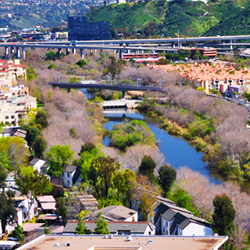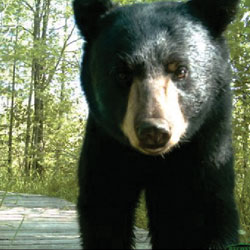An array of independent and uncoordinated land-use decisions often
leads to a landscape comprised of fragmented wildlife habitats which serve both human and wildlife needs poorly. Landscape ecology proposes instead to design landscape mosaics -- matrices of patches, corridors, and ecological edges -- to serve a broader and more diverse range of ecological systems and functions. Comprehensive land-use planning and design done in this way will better promote the enhancement, protection, and management of landscapes that
support wildlife and provide ecosystem services to human populations.
The future of wildlife and wildlife habitat in rural, suburban,
and urban settings depend on an environmentally-responsible strategy of
land management that emphasizes a mix of spaces for people and
wildlife. The use of ecological information in the design process can
create a more positive union between land use and the natural
environment, and increase public awareness of wildlife, wildlife
habitats, and their value to human welfare. Wildlife and wildlife
habitat values should be considered early in the development process.
Organizations
Chicago Wilderness
Conservation International
National Wildlife Federation
Natural Capital Project
Nature Conservancy
UK Green Building Council Biodiversity Task Force
Urban Biodiversity, United Nations Environment Program (UNEP)
Wildlife Habitat Council
Resources
"Accidental Sanctuary: Korea's Demilitarized Zone," Audubon Magazine
"Along Scar from Iron Curtain, A Green Belt Rises in Germany," Yale Environment 360
"Biophilia: An 'Innate Emotional Affilation with Nature,'" The Dirt
"Better Crossing Design Can Reduce Collisions Between Wildlife and People," The Dirt
"Can Ecological Corridors Heal Fragmented Landscapes?" Yale Environment 360
Chicago Wilderness Ecological Planning and Design Directory
"Designing for the Full Range of Biodiversity," The Dirt
Interview with Carolyn Fraser, Author of Rewilding the World: Dispatches from the Conservation Revolution, ASLA
"Legacy of the Cold War: Germany's Green Belt," The Dirt
"Recreating Wildlife Habitat in Cities," The Dirt
"Restoring the Balance Between People and Nature Through Wildlife Habitat Design," The Dirt
"Taking Nature to the City," The Dirt
Government Resources
Wildlife Habitat Resources, Natural Resources Conservation Service, U.S. Department of Agriculture
Conservation Buffers: Design Guidelines for Buffers, Corridors, and Greenways, U.S. Department of Agriculture, National Agroforestry Center
Cambridgeshire County Council Green Infrastructure Strategy
Australia National Wildlife Corridors Plan, Australia Department of the Environment
Research
 ASLA 2011 Professional Landmark Award, First San Diego River Improvement Project, San Diego, Wimmer Yamada and Caughey / Image Credit: Kevin Walsh and Wimmer Yamada and Caughey
ASLA 2011 Professional Landmark Award, First San Diego River Improvement Project, San Diego, Wimmer Yamada and Caughey / Image Credit: Kevin Walsh and Wimmer Yamada and Caughey
"Greenspace Restorations: A Framework for Enhancing Bird Habitat Value of Urban Greenspaces in the Woonasquatucket Watershed, Rhode Island, USA," U.S. Environmental Protection Agency, 2013
"Status and trends of wetlands in the coastal watersheds of the Conterminous United States 2004 to 2009," U.S. Department of the Interior, Fish and Wildlife Service and National Oceanic and Atmospheric Administration, National Marine Fisheries Service, 2013
"Green Infrastructure & Habitat Conservation Plans," The Conservation Fund, 2011
“Conserving urban biodiversity? Creating green infrastructure is only the first step,”
Landscape and Urban Planning, 2011
"Climate Disruption and Biodiversity," Stuart Pimm. Current Biology, 2009
"The
'Habitat Backbone" as Strategy to Conserve Pioneer Species in Dynamic
Port Habitats: Lessons from the Natterjack Toad in the Port of Antwerp," Robbert Snep and Fabrice Ottburg. Landscape Ecology, 2007
“Biodiversity and Green Infrastructure in Urban Landscapes: The Importance of Urban Green Spaces,” Ulf G. Sandstrom, VDM Verlag, 2008
“Refinement of the Chicago Wilderness Green Infrastructure Vision Final Report,” Chicago
Wilderness with The Conservation Fund, June 2012
“Chicago Wilderness Green Infrastructure Vision Final Report.” Chicago
Wilderness 2004
“The Ecological City: Preserving and Restoring Urban Biodiversity,” Rowan A. Rowntree, Rutherford H. Platt, Pamela C. Muick, University of Massachusetts Press, 1994
Role of the Landscape Architect
 ASLA 2011 Honor Award. Half-Mile, Hand-Built Line: Berkshire Boardwalk / Image credit: Reed Hilderbrand
ASLA 2011 Honor Award. Half-Mile, Hand-Built Line: Berkshire Boardwalk / Image credit: Reed Hilderbrand
Landscape architects serve as dual advocates for both human and non-human communities. Landscape architects work with ecologists, conservation biologists, and other scientists to map existing and potential habitat patches and corridors, and then propose designs that protect critical habitats, connect fragmented green spaces, and weave together built communities and natural systems into a broader system that maximizes benefits.
Landscape architects often develop specialized knowledge in these areas: hydrology and riparian habitat for riverways; horticulture for native habitat planting; and ecology for systems.
Projects
Integrating Habitats: "Growing Together", Portland, OR (AECOM)
Arizona State University Polytechnic Campus — New Academic Complex, Mesa, AZ (Ten Eyck
Landscape Architects, Inc.)
Making a Wild Place in Milwaukee’s Urban Menomonee Valley, Milwaukee( Landscapes of
Place, LLC)
The Greenseams Program Preserve Guide (The Conservation Fund)
FirstSan Diego River Improvement Project, San Diego (Wimmer Yamada and Caughey)
Orongo Station Conservation Master Plan, Poverty Bay, North Island, New Zealand (Nelson Byrd Woltz Landscape Architects)
Ningbo Eco-Corridor - 3.3 km Living Filter, Ningbo, China (SWA Group)
Freshkills Park, New York (James Corner Field Operations)
Shelby Farms Park Conservancy
<< Forests & Nature Reserves
Urban >>